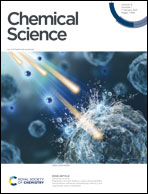U2N@Ih(7)-C80: fullerene cage encapsulating an unsymmetrical U(iv)![[double bond, length as m-dash]](https://www.rsc.org/images/entities/char_e001.gif) N
N![[double bond, length as m-dash]](https://www.rsc.org/images/entities/char_e001.gif) U(v) cluster†
U(v) cluster†
Abstract
For the first time, an actinide nitride clusterfullerene, U2N@Ih(7)-C80, is synthesized and fully characterized by X-ray single crystallography and multiple spectroscopic methods. U2N@Ih(7)-C80 is by far the first endohedral fullerene that violates the well-established tri-metallic nitride template for nitride clusterfullerenes. The novel U![[double bond, length as m-dash]](https://www.rsc.org/images/entities/char_e001.gif) N
N![[double bond, length as m-dash]](https://www.rsc.org/images/entities/char_e001.gif) U cluster features two U
U cluster features two U![[double bond, length as m-dash]](https://www.rsc.org/images/entities/char_e001.gif) N bonds with uneven bond distances of 2.058(3) Å and 1.943(3) Å, leading to a rare unsymmetrical structure for the dinuclear nitride motif. The combined experimental and theoretical investigations suggest that the two uranium ions show different oxidation states of +4 and +5. Quantum-chemical investigation further reveals that the f1/f2 population dominantly induces a distortion of the U
N bonds with uneven bond distances of 2.058(3) Å and 1.943(3) Å, leading to a rare unsymmetrical structure for the dinuclear nitride motif. The combined experimental and theoretical investigations suggest that the two uranium ions show different oxidation states of +4 and +5. Quantum-chemical investigation further reveals that the f1/f2 population dominantly induces a distortion of the U![[double bond, length as m-dash]](https://www.rsc.org/images/entities/char_e001.gif) N
N![[double bond, length as m-dash]](https://www.rsc.org/images/entities/char_e001.gif) U cluster, which leads to the unsymmetrical structure. A comparative study of U2X@C80 (X = C, N and O) reveals that the U–X interaction in U
U cluster, which leads to the unsymmetrical structure. A comparative study of U2X@C80 (X = C, N and O) reveals that the U–X interaction in U![[double bond, length as m-dash]](https://www.rsc.org/images/entities/char_e001.gif) X
X![[double bond, length as m-dash]](https://www.rsc.org/images/entities/char_e001.gif) U clusters can hardly be seen as being formed by classical multiple bonds, but is more like an anionic central ion Xq− with biased overlaps with the two metal ions, which decrease as the electronegativity of X increases. This study not only demonstrates the unique bonding variety of actinide clusters stabilized by fullerene cages, showing different bonding from that observed for the lanthanide analogs, it also reveals the electronic structure of the U
U clusters can hardly be seen as being formed by classical multiple bonds, but is more like an anionic central ion Xq− with biased overlaps with the two metal ions, which decrease as the electronegativity of X increases. This study not only demonstrates the unique bonding variety of actinide clusters stabilized by fullerene cages, showing different bonding from that observed for the lanthanide analogs, it also reveals the electronic structure of the U![[double bond, length as m-dash]](https://www.rsc.org/images/entities/char_e001.gif) X
X![[double bond, length as m-dash]](https://www.rsc.org/images/entities/char_e001.gif) U clusters (X = C, N and O), which are of fundamental significance to understanding these actinide bonding motifs.
U clusters (X = C, N and O), which are of fundamental significance to understanding these actinide bonding motifs.
![Graphical abstract: U2N@Ih(7)-C80: fullerene cage encapsulating an unsymmetrical U(iv) [[double bond, length as m-dash]] N [[double bond, length as m-dash]] U(v) cluster](/en/Image/Get?imageInfo.ImageType=GA&imageInfo.ImageIdentifier.ManuscriptID=D0SC04677A&imageInfo.ImageIdentifier.Year=2021)
- This article is part of the themed collection: Celebrating the 110th Anniversary of chemistry at Soochow University


 Please wait while we load your content...
Please wait while we load your content...
![[double bond, length as m-dash]](https://www.rsc.org/images/entities/h2_char_e001.gif) N
N